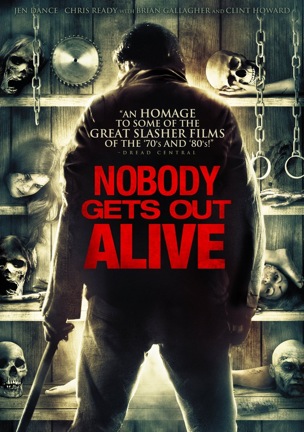Studio: Image Entertainment
Director: Jason Christopher
Writer: Jason Christopher
Producer: Roy Koriakin
Stars: Jen Dance, Chelsey Garner, David J. Bonner, Matthew Nadu, Shaun Costello, Nikki Bell, Chris Ready, Brian Gallagher, Clint Howard
Review Score:
Summary:
Seven friends party in the woods where a sadistic murderer is rumored to take revenge on campers for his daughter’s death.
Review:
A quote on the box cover dubs “Nobody Gets Out Alive” as “an homage to some of the great slasher films of the ‘70’s and ‘80’s!” For a film to be an homage, it has to display a reverential knowledge of the work(s) it is utilizing, as well as fashioning what came before into something with a new identity. “Nobody Gets Out Alive” does neither.
Homage are plentiful in horror. Effectively employed examples include Adam Green’s “Hatchet” films. “Hatchet” is a throwback slasher movie, but it winks at the tropes it pastiches and creates its own personality with a haunted Louisiana swamp setting and lively characters. The faux trailers between Rodriguez and Tarantino’s “Grindhouse” features also fit the bill. They make something new using the style of something familiar.
“Homage” is also bandied about in horror since “unoriginal” is frowned upon in marketing text. “Nobody Gets Out Alive” recycles mainly the most generic staples of the slasher genre, which is why the movie feels dull and uninspired. Putting teenagers in the woods to be slaughtered by a maniac is a flimsy premise. Just because it has been done before does not make it an homage.
Little Ashley Isth has drawn her hopscotch court on the road in front of her house. Her father, Hunter, does not see the inherent danger in this, although the audience does, long before the shot of a boozing teenager behind the wheel of a car. To heighten the drama, the music swells after the car meets the girl, and Hunter strides towards the crime scene in slow motion. The question here is which is more overdone: the stray child in the road or the slow motion reaction of the parent?
Allowing your daughter to play hopscotch in the road is just asking for trouble.
Between Mrs. Voorhees and Louis Creed, grieving parents in horror movies are prone to choosing poor ways of processing loss. Hunter Isth is no exception. Blaming drunk teenagers for his daughter’s tragedy, Hunter abandons all sense of reality and takes to a life of murdering anyone who camps in the woods. Although camping nearby is not the only way to introduce your skull to Hunter’s sledgehammer. Hunter also wordlessly murders the local shopkeeper and her employee, presumably because they sell the beer that campers use to get drunk?
Also abandoning all sense of reality are the seven friends who decide camping here would be a good idea. People are attracted to legends and like to tempt fate by traipsing through reportedly haunted houses and sleeping where ancient witches make spooky sounds. But this is not a ghost story. Hunter Isth is a real person. No one has seen Hunter since his daughter’s death and reportedly “nobody gets out alive” when it comes to the woods. “Hey guys! Want to do something scary this weekend? You know that real life serial killer that has never been caught near that campsite without cell phone service where all those people keep disappearing? Yeah, let’s go there!”
“Nobody Gets Out Alive” devotes real time to character development, although not enough time to character motivation. When “Final Girl” escapes to the presumed safety of a passing motorist, she feverishly explains with a bloodied face that her friends have been butchered by a maniac and she needs help. The motorist pledges to take her away from the killer on the loose, right after he stops for the mystery man flagging him down in the middle of the darkness. Because this will end well.
For a campers stalked in the woods story, the movie does spend more time than most offering backstories and personalities, which gives this group of victims a decent definition. Their characters are actually undercut by their boring deaths, however. Hunter Isth is not an iconic slasher figure. He is a balding countryman with an average build, distinguished mainly by his Grizzly Adams beard. Hunter is not a menacing silhouette and he usually fells his victims with a single hammer blow. Frankly, it is just not satisfying.
“Nobody Gets Out Alive” has inconsistent techniques in fabricating scares. When two victims escape Hunter’s grasp and hide, the camera follows Hunter as he quietly stalks his prey. But because the scene never shows where the escapees are hiding, there is no suspense to the search. Maybe he is close. Maybe they are covering their mouths to prevent any screams. Maybe they are dangerously close to knocking something over and giving themselves away. Or maybe they are in another room entirely.
Curiously, the film redoes this scene the right way a few minutes later when one of the escapees hides under a platform and the killer’s boots are seen pacing in front of her. Which is micro example of the movie’s macro issue. Partying teenagers in the woods. A deranged stalker. Campfire tales. A crazy man with a warning. It is a not a thoughtfully assembled homage, but a collection of borrowed tropes that fail to make a cohesive whole. “Nobody Gets Out Alive” does not feel like it is honoring classic slashers as much as it feels like it is adding to their diminished reputation by throwing things in a pot and hoping to cook up a gourmet dish with only the basest ingredients.
NOTE: There is a post-credits scene. "Nobody Gets Out Alive" is also known by the titles “Down the Road” and “Punishment.”
Review Score: 30







How someone who sees this in a theater or without a notepad can keep everyone and their relationships straight, I have no idea.